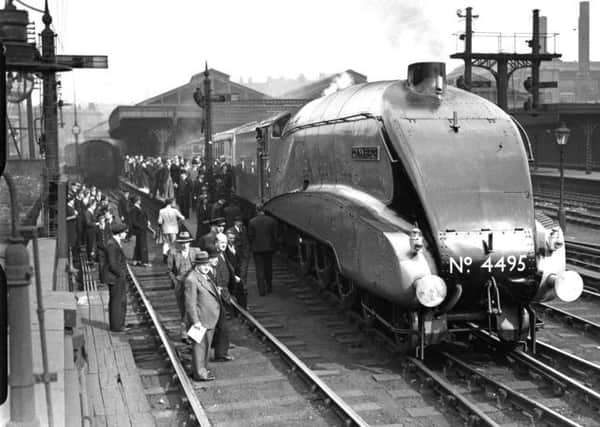Why can’t rail travel still be like this?


As the London & North Eastern Railway’s chief mechanical engineer, Gresley was impressed by the much publicised ‘Flying Hamburger’ high-speed train services in Germany and the Bugatti railcars in France. The LNER wanted similar services between King’s Cross and Newcastle. The locomotive designed by Gresley for the job was the A4.
All the locomotives in this class were Doncaster built and the first one to emerge was No. 2509 Silver Link. A special train of carriages – the Silver Jubilee set – was built at Doncaster Plant Works for the new high-sspeed service.
Advertisement
Hide AdAdvertisement
Hide AdThe group of carriages comprised seven vehicles, two articulated twins and a Restaurant/Kitchen Car triplet and was largely intended to cater for businessmen.
Some exquisite new schemes of decoration were introduced and the passenger accommodation was the last word in comfort.
A novelty in the first-class section was that all the lighting, except the table lamps in the restaurant cars, was with tubular lamps. Australian maple panelling, leather-look Rexine in soft shades of colour, silver and blue silk curtains, mirrors, loose cushions and specially sprung seats all played their part in the first-class coaches. The third class was equally notable in its comfort and modernity. The walls were flush panelled in quartered teak, the fittings being chromium plated. All the vehicles had steel body panels and were covered externally in silver-grey Rexine with stainless steel trims.
On its final trial run on Friday September 27 1935, the Silver Jubilee train smashed four world records between King’s Cross and Grantham. After the record-breaking run Nigel Gresley sent a telegram to R.A. Thom, the Doncaster Works manager, congratulating him and the staff. “I much appreciate your cooperation,” he said.
Advertisement
Hide AdAdvertisement
Hide AdTwo years later Doncaster Works was entrusted to build the Coronation train sets, to coincide with the Coronation celebrations of King George VI. The carriages operated on the London-Edinburgh route. Each train consisted of four twin articulated coaches. There were two kitchen cars in each train set but there were no restaurant cars as it was intended that all passengers should be served in normal seats.
The coaches were teak framed with steel body panels and the exterior was painted in Marlborough blue and Garter blue. The roofs were spray painted in aluminium finish, the bogies were painted black and the wheels were red. Seats were provided for 48 first-class and 168 third-class passengers
Messrs Acton Surgey Ltd were responsible for the decor. Wall coverings were in two shades of grey-green Rexine and were divided by the fretted trim. Lavishly upholstered swivel armchairs, one on each side of the gangway were fitted in First Class saloons. The overall colour scheme again was green. During the summer a beaver-tailed observation car was attached to the rear of the train. It accommodated 16 passengers who paid one shilling (5p) to occupy a swivel armchair for an hour.
The Coronation train was tested on a section of line between Edinburgh and Newcastle with heavy gradients and also with severe congestion from local traffic. There was also a problem of winds from the North Sea. But the main features were the remarkable steadiness of the running and the absence of any sensation of excessive speed.
Advertisement
Hide AdAdvertisement
Hide AdAnother prestigious group of Doncaster-built carriages, which appeared in 1937, was the West Riding Limited set. Intended to operate on the Leeds-Bradford-King’s Cross service, the carriages were almost identical in design to those produced for the Coronation sets.
The train was timed to leave Bradford at 11.10am or Leeds at 11.31, arrive in London at 2.15 and get back to Leeds at 9.53 and Bradford at 10.15. The Lord Mayor of Leeds, Tom Coombs, a guest on the trial trip, said it would be of invaluable service to businessmen.
As the train passed through Doncaster, workmen and station officials turned out in force to watch. At various stations, including Wakefield, children lined up to see it pass. To shut out noise, floors, walls and roof were blanketed with asbestos and rubber.
The bridges between carriages were carpeted so that passengers did not realise they were crossing them.
Advertisement
Hide AdAdvertisement
Hide AdAlong with other streamlined sets, the West Riding Limited carriages were put in store for the Second World War. In 1949 a number of carriages were the first to be painted at Doncaster in the new crimson and cream livery. All the stock, except for several burnt out in service, continued to operate until they were replaced by standard coaches.